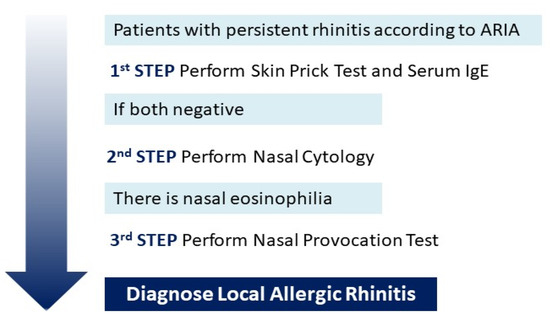(This article belongs to the Section Clinical Laboratory Medicine)
Abstract
A Nasal Provocation Test allows the differentiation of allergic and non-allergic rhinitis, but it is difficult and expensive. Therefore, nasal cytology is taking hold as an alternative. We carried out a cross-sectional study, including 29 patients with persistent rhinitis according to ARIA definition and negative skin prick tests. Nasal symptoms were scored from 0 to 5 using a visual analogue scale, and patients underwent blood tests to investigate blood cell count (particularly eosinophilia and basophilia), to analyze serum total and specific IgE and eosinophil cationic protein (ECP), and to perform nasal cytology. We performed a univariate logistical analysis to evaluate the association between total serum IgE, serum eosinophilia, basophils, and ECP and the presence of eosinophils in the nasal mucosa, and a multivariate logistic model in order to weight the single variable on the presence of eosinophils to level of the nasal mucosa. A statistically significant association between serum total IgE levels and the severity of nasal eosinophilic inflammation was found (confidence interval C.I. 1.08–4.65, odds ratio OR 2.24, p value 0.03). For this reason, we imagine a therapeutic trial with nasal steroids and oral antihistamines in patients with suspected LAR and increased total IgE levels, reserving nasal cytology and NPT to non-responders to the first-line therapy.




No comments:
Post a Comment